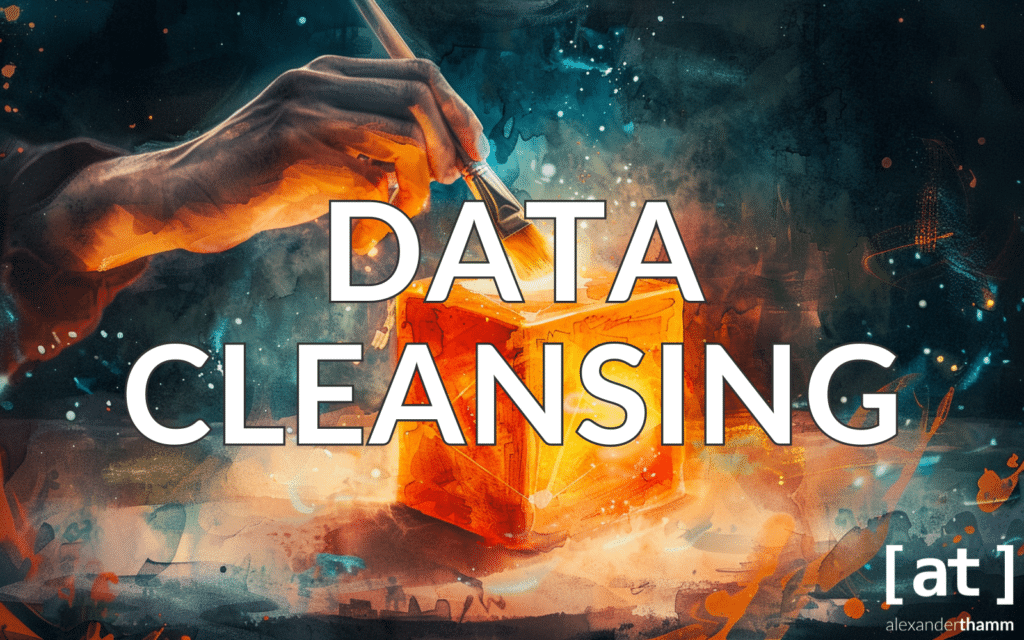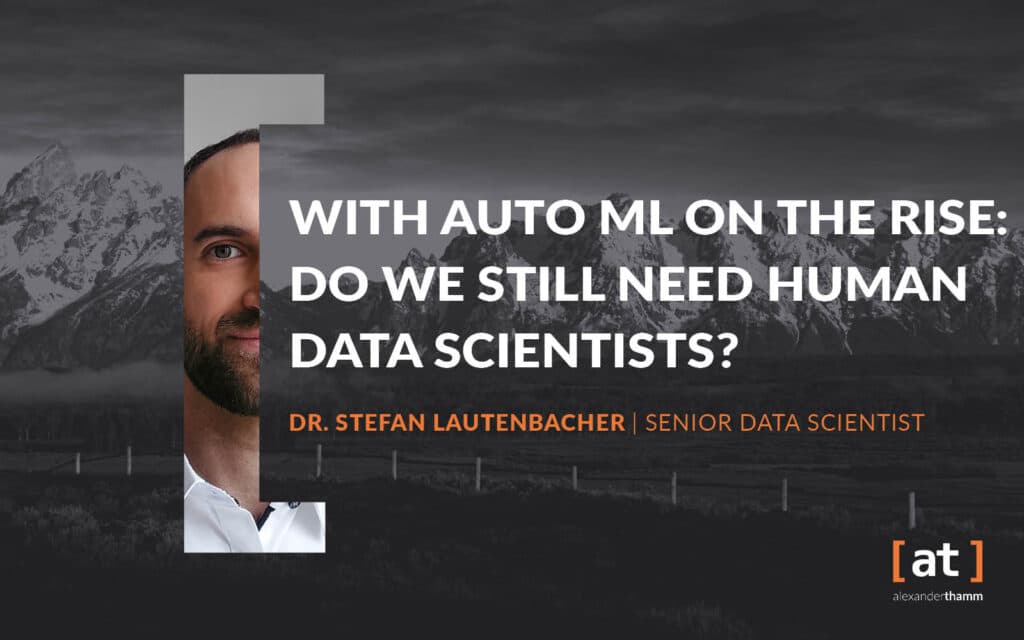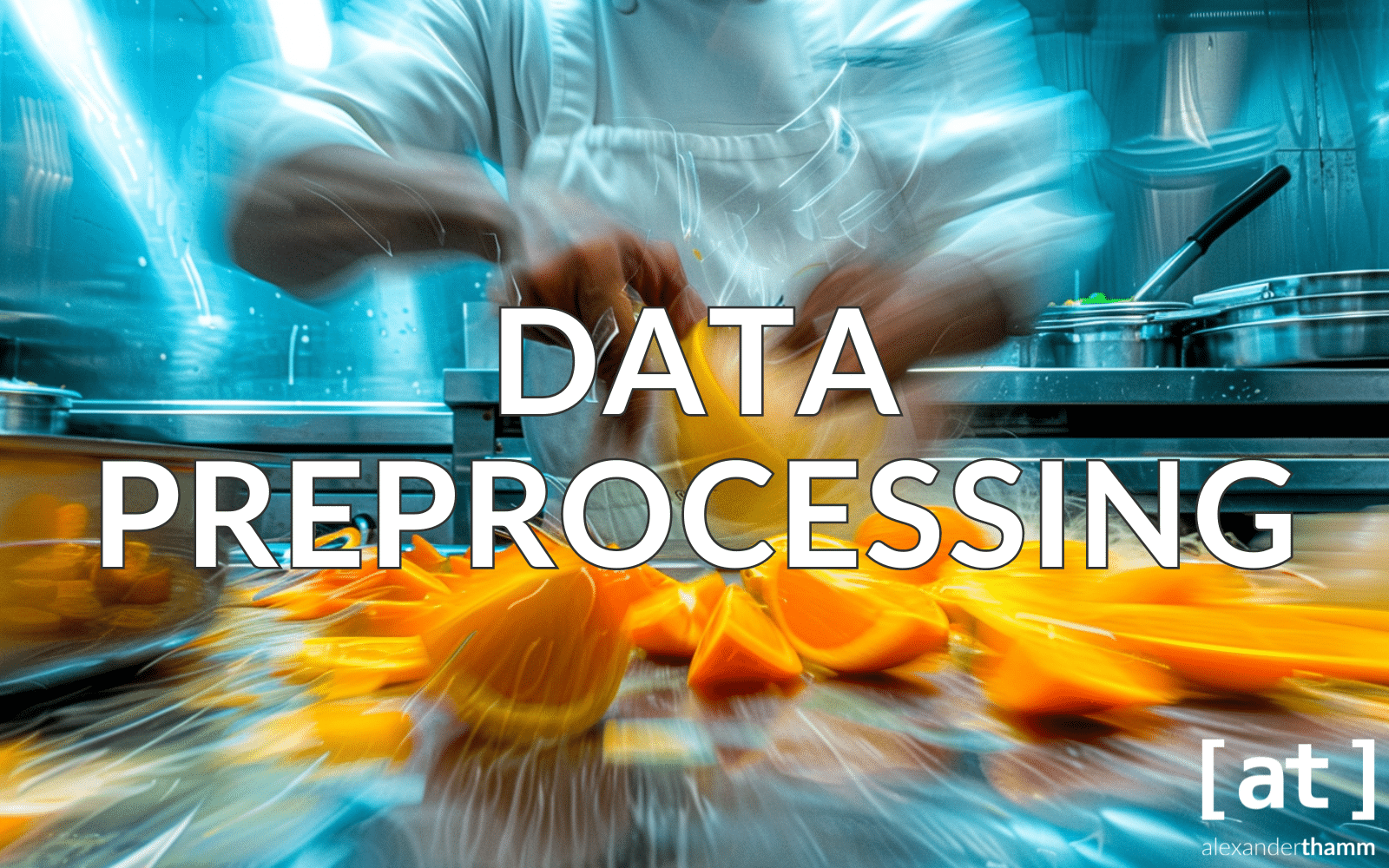As data-driven decisions characterise almost every sector and industry, data has reached a level of importance that is often compared to oil. Much like oil, it requires careful processing and handling before it can be of any use. This is where one of the most important processes in data processing comes into play: data preprocessing.
Inhaltsverzeichnis
What is data pre-processing?
Data from the real world can prove to be incomplete, inconsistent and generally immature. This makes it difficult to use real-world data for Data analyses and tasks of the machine learning. This is where data pre-processing comes into play.
Data pre-processing ( Data preprocessing) is an essential step in data analysis and machine learning, as it Raw data into a clean, machine-readable data set which allows models to work more effectively. It also eliminates problems such as missing values, outliers and other errors in the system. When done correctly, data pre-processing lays the foundation for accurate results with meaningful insights.
Benefits of data pre-processing
Data from the real world is fraught with problemsThese include missing values, errors, outliers that do not fit the general trend, or inconsistent representation of information. These problems can significantly affect the performance of machine learning models, as these models rely on clean, well-structured data to make accurate predictions or recognise patterns.
- Improves the accuracy of the model: The accuracy of your model is improved by removing noise and erroneous Data improved. This means that the machine learning model can deliver better insights without being slowed down by anything.
- Enables effective scaling and normalisationPre-processing can lead to better results such as normalisation and scaling. Normalisation and scaling make the data more balanced and fair for better analysis. This means that the performance of the machine learning model can be significantly increased.
- Facilitates feature extractionDuring pre-processing, it is possible to create new features from the existing ones, a process known as Feature Engineering is known. This can be as simple as creating a new column that represents the day of the week of a date, or more complicated transformations based on domain knowledge. This helps the model to find new patterns and relationships. This means you can get more insights.
- Resolving inconsistenciesData from the real world can have inconsistencies, e.g. different names for the same element or differences in capitalisation and spelling. By standardising these values, you reduce the complexity of the data and make it easier for the model to process.

Good data quality not only ensures the reliability of operational processes, but also protects against high financial risks due to data errors.
4 Steps in data pre-processing
Although data pre-processing can be divided into many steps, it can generally be broken down into 4 main steps:
- Data cleansing
- Data integration
- Data reduction
- Data transformation
1. data cleansing
Data cleansing (also known as Data Cleansing or data cleaning) is the first step in the process of pre-processing data. As the name suggests, this step focuses on this, Find and correct errors in the data recordbefore the next phase begins.
One of the main tasks in data cleansing is dealing with missing values. Data Engineers deal with missing values by either deleting records with missing values if they are not critical to the analysis, or by filling in missing values with estimates based on other data points.
In addition, the following measures are taken during the clean-up process:
- Ensure that all data has a standardised format, which is particularly important for dates, categories and numerical values.
- Correction of errors in the data set, whether due to typing errors, incorrect values or incorrectly classified categories.
- Identify outliers and remove or adjust them to prevent them from distorting the analysis.
2. data integration
Data integration is the part of data pre-processing that is responsible for the merges data into a standardised view and data from different sources in a single data set. This process involves combining different schemas and metadata from different sources. By successfully integrating data, duplicate data is reduced, the data set becomes more consistent and our analyses become more accurate and meaningful.
This step is closely linked to data cleansing. Before we can integrate data from different sources, we have to cleanse it. This means that we have to correct all errors, add missing values and ensure that everything is in a standardised format. Only after cleansing can we combine the data effectively. This ensures that we are working with the best quality data when combining information, such as CT images from different medical devices. This is important in real-life situations where the integration of data can provide greater and more useful information. Database is created, e.g. when combining images from different sources to obtain a more complete overview of a patient's condition.
Advantages of data integration:
- By integrating data from different sources, companies can obtain a standardised view of their processes and environment.
- Data integration automates the collation of data from different sources. This reduces manual data processing.
- When data from different sources is combined and made consistent, its usefulness and value for analysis increases considerably.
3. data reduction
Data reduction techniques contribute to data pre-processing by minimising the Minimise volume while preserving data integrity. Methods such as the selection of subsets of attributes are used to eliminate irrelevant features through step-by-step selection or decision tree induction.
Dimensionality reduction is also a sub-technique of data reduction, in which the number of attributes is reduced. In numerosity reduction, on the other hand, the volume of the original data is reduced by parametric methods, i.e. the parameters are stored instead of the actual data, and by non-parametric methods, in which the data is stored in representations such as a smaller sample of the original data set.
Overall, these strategies efficiently reduce and distil larger data sets and enable more streamlined and filtered data analysis so that the process runs smoothly.
4. data transformation
The final step in data pre-processing consists of the Conversion of the data into a format that is best suited for further analysis. In this phase of data transformation, methods such as normalisation, scaling, binning and coding are applied.
Normalisation adjusts the values to a common scale without distorting the data, while scaling changes the data range, binning groups a continuous set of values into a smaller number of bins and finally encoding transforms the categorical data for machine learning.
Together, these conversion methods ensure that the data is available in a format that is optimised for the algorithms. This completes the process of data pre-processing, which ensures that the data is ready for the machine learning models.

Data cleansing is crucial for improved data quality and data consistency. Find out how to overcome challenges and utilise the benefits in your company in our blog post:
Data pre-processing techniques
Data pre-processing includes several techniques for cleansing and converting the data. These techniques are used in the 4 main steps to optimise their function.
Dimensionality reduction
This technique is used to reduce the number of input variables in a data set and thus reduce high-dimensional data to a lower dimension. Dimensionality reduction helps to improve the efficiency of machine learning algorithms while increasing the accuracy of the results. The two main methods of dimensionality reduction are feature selection, in which a subset of the original data is selected, and feature extraction, in which new features are created to capture the essential information in the original data.
Feature technology
The process of adding new features or modifying existing features to optimise the performance of a machine learning model is known as feature engineering. In this method, relevant information is extracted from the data sets and converted into a format that a model can understand. Feature engineering also includes sub-techniques such as extraction, scaling and feature selection, which significantly improve the performance of the model.
Sampling of data
The sampling data technique in data pre-processing has the function of selecting a subset of data from a data set to represent the entirety of the data. This serves to simplify the process of data analysis and reduce the computational load, which in turn leads to a faster insight into the data. However, it is important to ensure that the sample data selected is truly representative of the entirety of the data in order to maintain the accuracy of the analysis.
Handling data with uneven distribution of classes (unbalanced data)
The unbalanced data technique includes strategies to equalise the class distribution. Strategies include oversampling the minority class, undersampling the majority class, or in some cases a combination of both. These methods help to improve the accuracy of the data and the performance of the machine learning model by ensuring that the model is not biased towards the majority.

Find out how data mining helps companies to gain hidden insights from large amounts of data using analytical techniques and tools.
How can data pre-processing be automated?
The automation of data pre-processing is a significant advance in data processing and data science as a whole. By automating routine tasks such as dealing with missing values, coding variables, scaling and other time-consuming activities, it is possible to Data Scientists refrain from high-priority tasks that require their strategic decision-making.
This not only speeds up the workflow, but also eliminates the possibility of human error and ensures that consistency and accuracy are maintained throughout the process. The obvious reliability in automating data pre-processing is crucial when it comes to maintaining the integrity of the data.
This is because automating data pre-processing improves the reproducibility of data by grouping the individual steps into predefined workflows to ensure consistency across different data sets and projects. The importance of automating data pre-processing increases with the complexity of the data and enables data scientists and data analysts, Big Data more efficiently and gain more meaningful insights from their analyses.
Various tools and techniques enable the automation of data pre-processing:
Data preprocessing with Python
The use of Python for the automation of data pre-processing is common practice in the data science and machine learning community. With its extensive library support, Python provides the necessary tools for this. The syntax is intuitive and easy to learn, enabling the rapid development and implementation of scripts for data pre-processing. This capability is essential for automating repetitive tasks such as data cleansing, transformation and feature extraction.
Pandas is indispensable for automating the manipulation of structured data, as its DataFrame object enables complex data operations with simple commands. This makes tasks such as data cleansing, filtering and aggregation both simple and automatable.
NumPy supports the automation capabilities of Python by providing an efficient array handling system that is critical for performing high-speed mathematical operations on large data sets. This is particularly useful for automating numerical calculations in the pre-processing phase.
Scikit-learn extends the automation strengths of Python to the area of machine learning. It automates common tasks such as the imputation of missing values, the normalisation of data and the coding of categorical variables.
Visualisation tools such as Matplotlib and Seaborn further automate the process of exploratory data analysis.
The combination of these libraries together with the general design of Python makes it an ideal platform for the automation of data pre-processing.
Data preprocessing with R
R is an excellent tool for automating the data pre-processing required to convert raw data into an analysable format. Its rich ecosystem of packages automates and simplifies complex tasks, making R a favourite among data scientists.
Tidyverse is a collection of R packages specially designed for the Data Science have been developed. They provide tools for everything from manipulating with dplyr, cleaning up with tidyr, quickly reading data with readr to improving functional programming with purrr.
Janitor is ideal for cleansing data and offers simple functions for removing duplicates, correcting data types and removing spaces, which greatly simplifies the process of cleansing data before it is analysed.
Psych is tailored to psychological research, but can also be used for basic data cleaning, recoding categorical variables into numerical formats and facilitating dimension reduction, enriching the functionality of R for data scientists of all disciplines.
Together, these tools enable users to cleanse and pre-process data efficiently.
When should automation be avoided?
Although automating data pre-processing can save time and effort for the professionals involved, it is important that certain factors are considered before the process is automated.
Automation should be avoided if
- the data sets are too small. In such cases, automation can unintentionally contribute to a perceived distortion of the model. It is also inefficient, as the complexity of the set-up process would outweigh the time savings.
- the data sources are unreliable, the automated pre-processing is not able to make the necessary adjustments and error corrections to react.
- the data in the data records require special handling, automatic pre-processing may not be suitable. Certain data types, for example, require specialised knowledge for appropriate pre-processing.
- When handling sensitive/confidential data, manual control is better than automatic pre-processing, as this is a better way of ensuring that no data breaches occur.
In these situations, it is best to stick with manual data pre-processing to ensure that your data is handled properly and with the appropriate care.

Automated machine learning (Auto ML) increases the productivity of data scientists by taking over repetitive tasks without making them redundant. Find out more about this exciting topic in our blog:
On the way to data analysis
Overall, data pre-processing is an important process in the context of machine learning and data analysis. Cleaning, integration, reduction and transformation are essential to maintain the accuracy of the data provided to the machine learning model and to gain valuable insights. Although automating this process is practical in some cases, in other cases it is important to consider manual pre-processing.











0 Kommentare